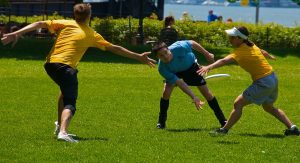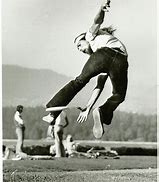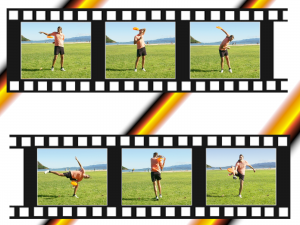 Part of FrisbeeGuru’s mission is to aide in the growth of Freestyle Frisbee. In this guest post, Ken Westerfield shares his vision for sharing Freestyle to Ultimate players. Ken is a Frisbee (disc) player from the 1960s and a Hall of Fame inductee in freestyle, ultimate and disc golf. Thanks, Ken, for this submission!
Part of FrisbeeGuru’s mission is to aide in the growth of Freestyle Frisbee. In this guest post, Ken Westerfield shares his vision for sharing Freestyle to Ultimate players. Ken is a Frisbee (disc) player from the 1960s and a Hall of Fame inductee in freestyle, ultimate and disc golf. Thanks, Ken, for this submission!
“All disc sports are rooted in early freestyle play. No disc sport plays at a higher level of handling skill than freestyle, therefore it stands to reason that any disc sport requiring any degree of disc handling skill could be greatly advantaged by having skill in freestyle”.
Even before the game of Gut’s, people were trick throwing and catching the Frisbee behind the back and under their legs, freestyle, although not yet called that, was the original play with a plastic flying disc, maybe even with the pie tin. Freestyle competitions and the touring freestyle performers in the 1970s were the events that began showing people that Frisbee skills could be more than just recreational beach play with a toy. Popular, competitive disc sports like ultimate and disc golf are excellent flying disc games and are much better than their ball counterparts, but as a skilled flying disc handling activity, there’s nothing more uniquely, self-challenging than playing freestyle with a flying disc. As disc sports become more popular, freestyle may evolve in content and direction. More freestyle-like games and events may become new disc sports in the future. In the meantime, since there are elements of freestyle play in every disc sport, it’s time to start convincing disc athletes to include some form of regular freestyle play as a good exercise for handle-skill improvement. As their freestyle skill evolves they will gain an appreciation for freestyle as a sport and a few may even make the conversion to freestyling for fun and even competitively.
There’s a potential for a new generation of young freestylers, currently playing other disc sports, especially ultimate. Ultimate is fast becoming the breakout disc sport of the future, using many of the freestyle throwing techniques that made early freestyle popular. Ultimate’s flying disc uniqueness, mixed gender competition, ease of play anywhere without restrictive equipment, as well as a working self-imposed attitude of good sportsmanship (SOTG), during a competition, is going to make ultimate a very popular sport in the future. I would never want to see freestyle catching included into the game of ultimate (keep it simple), but if we can show ultimate players that there are some playing benefits that can come from learning freestyle throwing and catching, as a training option, freestyle could end up sharing ultimate’s future playing popularity.
Freestyle, prior to 1975: Play was fast and throws were hard with a smaller Pro Model Frisbee. The play would actually resemble a good tennis volley, especially when done on a hard surface, with lots of running, jumping and fast freestyle catching. After 1973, tips and kicks were invented, larger Frisbee’s were preferred, then came delay moves, and the game began to change. So by 1975, the quick, throw, catch and flow game was over. However, this early version of freestyle play, using a 175g ultimate disc instead of a Pro Model, could interest and benefit ultimate players. An uncomplicated freestyle option that would be easy to learn with play similar to the running, throwing and catching skills used in today’s ultimate. I know the benefits because this is the type of freestyle play I did before I played ultimate and I know how much having this freestyle throwing and catching skill advantaged me as a handler.
I originally wrote these ultimate handle-training articles a few years ago for ultimate players, to be read at several online ultimate websites, Fast Freestyle the Ultimate Edge on Ultimate Rob and 8 Reasons to Include Freestyle to Your Ultimate Training on Ultiworld’s site. It promotes fast-freestyle, speed-flow, (early freestyle, pre-1975) as an “extreme throw and catch exercise” for ultimate players.
Most sports do have a freestyle component for a reason. Professional soccer players can bounce a soccer ball on their head, knees and feet almost endlessly without a break. This skill does not come with the play of the game, it’s a skill that has to be developed. As well as practicing their timing, they do this routine to develop their mental and physical connection with the ball. This skill is as much a mental exercise as it is physical. As a result of this exercise, soccer freestyle is becoming popular and has its own competitions.
To develop playing skills in any sport, it helps to include multiple training activities that can isolate and improve every playing skill and strength that is required for that sport. Athletes often include cross-training sports to improve skill and strength in their primary sport. Freestyle is the cross-trainer for all other disc sports. Ask any ultimate player that has freestyle skill and I’m sure that they will agree. Ultimate is not a complicated game. There still isn’t much in the way of strategic plays with coaching genius. There’s man or zone, don’t clog up the passing lane. It’s a game of throw and catch, the team that makes the least amount of mistakes doing that, wins.

Photo by Ed Yourdon
In my “Freestyle for Ultimate Handle Training” articles, there are techniques of freestyle play outlined that as freestylers you can convincingly present to friends and disc athlete’s who play ultimate and other disc sports. You will see, if you read my articles, I’m not promoting delay moves, the use of delay paraphernalia or even spray for this exercise. Ultimate players have already shown that they enjoy running, throwing and catching and are already doing many of the throws that we used to consider to be freestyle throws, even air-bounce. So for freestylers that know this type of play and are already involved in ultimate, whether competing or organizing ultimate events; presenting a basic throw and catch, pre-delay version of freestyle is a great place to begin, allowing ultimate players to easily see a type of freestyle play that most closely resembles the skills required for their own disc sport. Once new players are able to experience the basic fundamentals and original play of freestyle and realize it’s potential, they can play freestyle anyway they like.
I’m not saying freestyle skills are always necessary for handle-skill improvement but for ultimate players that already have excellent handle-skills, it could just be an effective (cross-training) way to improve, strengthen and maintain them. For the ultimate player just starting out, freestyle could be a fast and fun way to learn handle-skills, especially for wind conditions and catching with one-hand. In the future when ultimate teams are looking for every competitive edge, I have no doubt that freestyle will be an integral part of ultimate training. I feel that a throw and catch freestyle, as a training exercise for ultimate handling skills, could be compared to the mental and physical abilities that can be derived from martial arts training and how that type of training can assist in developing confidence and skills that are used in fighting sports. If we want new players to check out freestyle, we need to take the sport to them, by showing players of other disc sports that freestyle isn’t a different activity with unique skills, but can also be played as a fun similar skilled activity, improving the handle-skills for the disc sport they already play.
In the future, I’m still not sure if freestyle will be popular as its own competitive sport or be more of an art-form recreation, exercise or skilled discipline, like dance and martial arts. Either way the future is bright for freestyle. As long as some disc sports are growing in popularity, freestyle will always be there, as an alternative or addition to competitive disc sports. I know that as new ultimate players go to the parks and athletic fields to practice their two-handed rim and clap catching, that either by accident or intent, they will eventually try something a little different with a throw or a catch and when they do, that’ll be it.
Ken Westerfield
Note: What I’ve outlined, is a way for freestylers already involved in other disc sports, like ultimate or disc golf, to grow interest in freestyle, by presenting a simple non-paraphernalia freestyle play option that might appeal to athletes of other disc sports. Start with the basic throw and catch, the main attraction and common activity most closely related to all the disc sports. Today’s freestylers should not only think of themselves as players and jammers but also think of themselves as pioneering and teaching a disc sport that is still developing. The big difference between yesterday and today’s freestyle potential is that today there are millions of people and disc sport players that have accepted the flying disc as an implement to be used in sport. I’ve played all the disc sports well enough to understand what each sport has to offer athletically and I know without a doubt that what freestyle has to offer, no matter how you choose to play it, is unparalleled in its play.There’s no score keeping or competition necessary to enjoy freestyle. Freestyle is completely unique to the flying disc and there’s no other sport or recreation like it.
Videos of freestyle Throwing and Catching
A short film of throw and catch freestyle by early freestyle champion Krae Van Sickle
https://www.youtube.com/watch?v=MN-Gz-x5Jf4&feature=youtu.be
Freestyle throwing by DC Breeze ultimate player Rowan Mcdonnell. Maybe not realizing that these are early freestyle throwing techniques. Because nobody has seen freestyle throwing styles since the 1970s, they think these throws are new and for new ultimate players, they are.
Ultimate players playing freestyle in between ultimate games. This is what we should be seeing at every ultimate tournament
https://www.facebook.com/100016491286032/videos/179921149234260/
About Ken Westerfield





